If you’re interested in the cutting-edge RFID tags transforming wildlife conservation, I’ve found some great options. These include waterproof NFC stickers, fish and bird-specific tags, and nano-sized implants. They’re made from durable, eco-friendly materials, compatible with various standards, and designed for easy attachment or implantation. Whether for aquatic, bird, or terrestrial wildlife, these tags support long-term tracking in harsh environments. Keep going, and you’ll discover detailed insights into each innovative solution and how they’re making a difference.
Key Takeaways
- The article highlights various RFID tags tailored for wildlife, including NFC stickers, PIT tags, bird rings, nano, and full duplex tags.
- It details materials, durability, and environmental resistance features essential for long-term outdoor and aquatic wildlife tracking.
- Compatibility with different RFID standards and data storage capabilities enable versatile applications in conservation research.
- Different attachment and implantation methods ensure animal safety, minimal discomfort, and effective long-term identification.
- Additional features like waterproofing, biocompatibility, and integration with real-time tracking devices enhance conservation efforts.

If you’re looking for a versatile and affordable RFID solution for wildlife tracking, the Pcs NFC Tags Stickers with NTAG213 chips are an excellent choice. These waterproof, eco-friendly stickers are made from durable PET material, ensuring they withstand outdoor conditions. With a small 25mm size and ultra-thin design, they easily attach to surfaces without drawing attention. Rewritable and compatible with all NFC-enabled smartphones, they support quick data sharing and device pairing. Their 137-byte memory is perfect for simple data storage, and their long service life—over 10 years—makes them reliable for ongoing tracking projects. They’re ideal for quick, non-sensitive applications in conservation efforts.
Best For: DIY enthusiasts, small-scale wildlife trackers, and conservation projects needing affordable, waterproof RFID tags for non-sensitive applications.
Pros:
- Rewritable and compatible with all NFC smartphones for easy data management
- Waterproof, eco-friendly PET material suitable for outdoor use
- Compact, ultra-thin design (25mm) for discreet attachment
Cons:
- Limited 137-byte memory suitable only for simple data storage
- Not ideal for sensitive security applications due to low security features
- Variable performance and occasional incomplete data erasure in some cases
Air Tags 4 Pack Bluetooth Trackers for Apple Find My (iOS Only)
The Air Tags 4 Pack Bluetooth Trackers are an excellent choice for Apple users who want a seamless, secure way to keep tabs on their belongings. Compatible exclusively with the Find My app, they help locate keys, luggage, or backpacks within a 60-meter range, using a built-in speaker for sound alerts. They support Lost Mode, allowing nearby Apple devices to provide location updates and send notifications if items are left behind. Lightweight, durable, and waterproof with a replaceable battery lasting up to two years, these trackers are easy to set up and secure, making them a practical and cost-effective solution for preventing loss and ensuring peace of mind.
Best For: Apple users seeking a secure, easy-to-use, and reliable way to track their personal belongings within the Apple ecosystem.
Pros:
- Seamless integration with the Find My app on iOS devices, ensuring easy setup and use
- Durable, waterproof design with a long-lasting replaceable battery up to two years
- Loud sound alerts and Lost Mode features for effective item location and security
Cons:
- Exclusively compatible with Apple devices and the iOS ecosystem, limiting cross-platform use
- Limited Bluetooth range of 60 meters, which may not cover very large areas
- No built-in GPS, relying solely on the Find My network and nearby Apple devices for location updates

High-Performance Fish & Wildlife Pit Tags (50-Pack) are ideal for researchers and wildlife managers who need reliable, long-lasting identification solutions for aquatic animals and terrestrial wildlife. These 12mm x 2.12mm tags operate at 134.2kHz and are ISO 11784/11785 compliant, ensuring compatibility with common RFID readers. Made from transparent bioglass, they’re sterile, safe, and minimally invasive. The rounded design simplifies injection and reduces shedding risks, making them perfect for fish, turtles, and other wildlife. Packaged in secure vials, they support both field and lab research, offering durable, precise identification that’s essential for effective conservation and population management efforts.
Best For: Researchers, wildlife managers, and conservationists seeking reliable, long-lasting RFID tagging solutions for aquatic and terrestrial wildlife in both field and laboratory environments.
Pros:
- Made from sterile, bioglass material ensuring safety and minimal discomfort during implantation
- Compatible with ISO 11784/11785 RFID readers for seamless integration
- Rounded, injection-friendly design reduces shedding and tagging issues
Cons:
- Limited to 50 tags per pack, which may be insufficient for large-scale projects
- Requires RFID reader compatibility for effective use, adding equipment costs
- Not suitable for animals with very small or delicate tissues due to size and injection method
Among the 15 best wildlife tracking RFID tags, the RFID bird foot ring tags stand out as an essential tool for bird breeders and researchers. These reusable, lightweight rings are easy to put on and remove, making them ideal for tracking pigeons, chickens, and ducks. Made of durable plastic, each ring measures about 9x10mm and comes in random colors to help differentiate birds. They’re perfect for identifying similar-looking birds, managing hatchings, and tracking individual animals in outdoor environments. With a simple application process, these tags improve bird management and support conservation efforts through precise identification and data collection.
Best For: bird breeders, researchers, and conservationists needing reliable, reusable identification tags for pigeons, chickens, and ducks in outdoor environments.
Pros:
- Reusable and easy to attach or remove from birds, reducing costs over time
- Lightweight and durable plastic construction suitable for various bird species
- Comes in multiple random colors for easy differentiation and identification
Cons:
- Small size may be challenging to handle for some users during application
- Random color selection may require additional organization to track specific birds
- Limited instructions provided, which might be insufficient for first-time users
Full Duplex Nano Tags stand out for their tiny size and bioglass construction, making them ideal for researchers and wildlife managers who need minimally invasive, durable identification solutions for fish and marine animals. Measuring just 8mm x 1.25mm, these tags are biocompatible, sterile, and designed for easy injection, causing minimal discomfort. Compatible with ISO 11784/11785 RFID readers, they offer reliable, long-term tracking in both controlled environments and natural habitats. Sealed to prevent damage, these tags support applications like pond management, scientific research, and conservation efforts. Their affordability and durability make them a versatile choice for accurate, non-intrusive monitoring of aquatic wildlife.
Best For: Researchers, wildlife managers, and aquaculture professionals seeking minimally invasive, durable identification solutions for fish and marine animals.
Pros:
- Tiny size (8mm x 1.25mm) for minimal invasiveness and easy injection
- Biocompatible, sterile bioglass construction ensures safety and long-term durability
- Compatible with ISO 11784/11785 RFID readers, providing reliable data collection
Cons:
- Limited to aquatic and marine applications, not suitable for terrestrial animals
- Requires RFID reader compatibility for data retrieval, which may involve additional equipment
- Short-term availability starting October 4, 2024, so stock might be limited initially
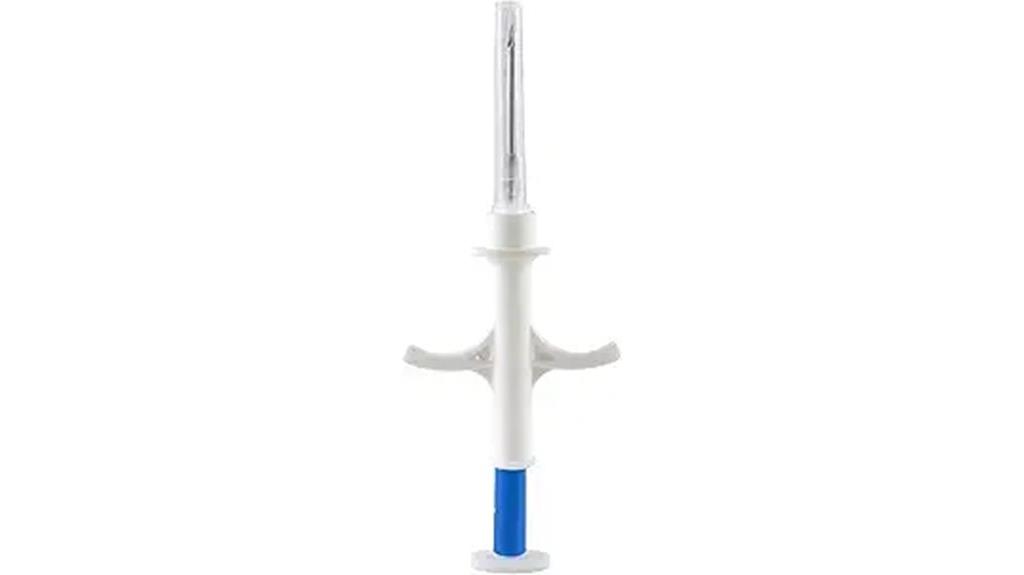
The Premium Fish & Marine Wildlife Pit Tag Implanter (10, White) is an ideal choice for researchers and pond managers who need a reliable, easy-to-use tool for fish identification and tracking. It features a 12-gauge needle compatible with 9mm and 12mm PIT tags, ensuring seamless implantation in aquatic environments. The device, equipped with a pushrod, plunger, and twist or luer-loc hubs, allows for painless microchip injections beneath fish skin, with or without anesthetic. Compact and lightweight at just 1.44 ounces, it offers precise, efficient implantation, making it perfect for fieldwork, laboratory studies, and pond management efforts.
Best For: researchers, pond managers, and wildlife scientists seeking a reliable, easy-to-use fish tagging tool for tracking and monitoring aquatic life in laboratory or field settings.
Pros:
- Compatible with 9mm and 12mm PIT tags for versatile application
- Painless microchip injection with or without anesthetic, ensuring fish safety
- Compact, lightweight design for easy handling in field and lab environments
Cons:
- May require training for precise implantation technique
- Limited to 10 units per package, potentially increasing costs for large projects
- Specific to fish and marine wildlife, not suitable for other animals
ETEKJOY 100pcs RFID Sticker Coins for Smart Locks

If you’re looking to upgrade your smart lock system with reliable RFID access, the ETEKJOY 100pcs RFID Sticker Coins offer an excellent solution. These round, 13.56MHz stickers are easy to use, with an adhesive back and a durable, waterproof design. Each coin measures 25mm in diameter and is pre-programmed for quick setup—no reprogramming needed. Compatible with popular systems like Tuya and TTLock, they work well with MIFARE Classic 1K cards. Ideal for adding or replacing access cards, these stickers are perfect for seamless integration into existing RFID systems, enhancing security and convenience for smart lock users.
Best For: homeowners and property managers seeking a reliable, easy-to-install RFID solution for smart locks and access control systems.
Pros:
- Easy to use with pre-programmed cards, no reprogramming required
- Waterproof and durable, suitable for various environments
- Compatible with popular systems like Tuya and TTLock, ensuring seamless integration
Cons:
- Not suitable for metal surfaces due to adhesive limitations
- Cannot be reprogrammed or customized after manufacturing
- Limited to 13.56MHz RFID systems, not compatible with other frequencies
Android Air Tracker 2 Pack: Smart Tracker for Keys and Luggage
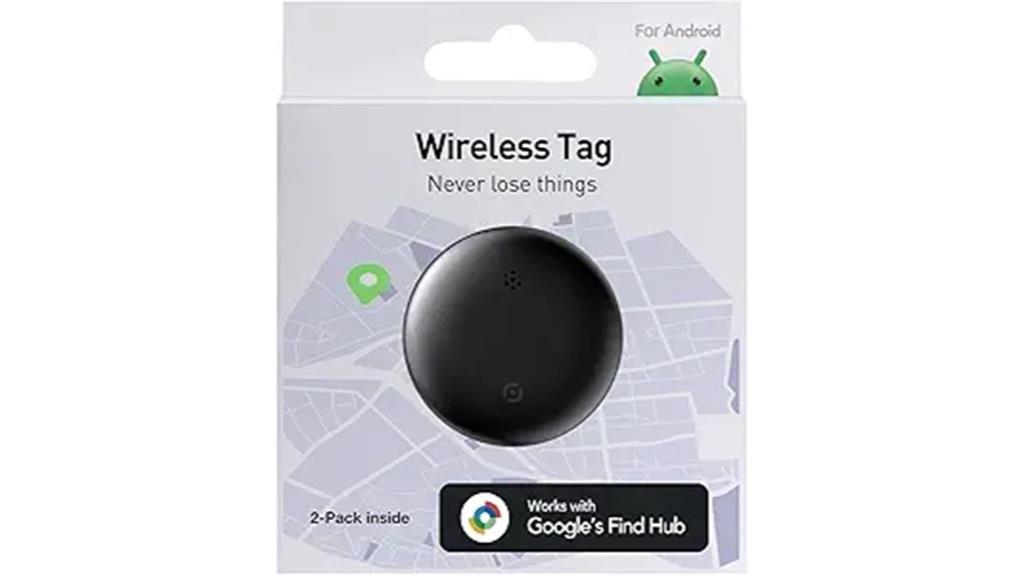
For anyone seeking a reliable, Android-compatible tracker for keys or luggage, the Android Air Tracker 2 Pack stands out. Designed exclusively for Android devices through Google Find My Device, it’s compact, lightweight, and durable, fitting easily on keys, backpacks, or pet collars. Its waterproof IP67 rating ensures it withstands daily wear and water exposure. The tracker offers real-time indoor and outdoor location updates, with a loud 90dB alarm for easy retrieval within 100 meters. With up to 12 months of battery life, simple setup, and privacy features like encrypted data, it’s an effective tool to prevent loss during travel or daily routines.
Best For: Android users seeking a reliable, waterproof tracker for keys, luggage, or pet accessories to ensure easy recovery and peace of mind.
Pros:
- Seamless integration with Google Find My Device for accurate real-time location tracking
- Long-lasting battery life of up to 12 months, reducing frequent replacements
- Compact, durable, and waterproof IP67 rated design suitable for various everyday items
Cons:
- Not compatible with Apple or iOS devices, limiting cross-platform use
- Some users may experience initial pairing difficulties with certain Android models
- Requires a compatible Android device and the Google Find My Device app for full functionality
Air Tag Bluetooth Tracker for Apple Find My
Among the top options for tracking personal items, the Air Tag Bluetooth Tracker for Apple Find My stands out with its seamless integration into the Apple ecosystem. It easily pairs via the Find My app, offering real-time location updates and offline tracking. Its compact size (just 7 grams) allows discreet placement in wallets, keys, or bags, while a built-in lanyard hole adds versatile attachment options. The rechargeable battery lasts up to three months, and a super-loud 100dB alarm helps locate items quickly. Waterproof and dustproof, it’s durable enough for outdoor use. Overall, users praise its reliability, ease of use, and seamless Apple ecosystem integration.
Best For: iOS users seeking a reliable, discreet, and durable Bluetooth tracker seamlessly integrated with the Apple Find My ecosystem for personal items.
Pros:
- Easy setup and seamless integration with Apple Find My app for real-time tracking.
- Compact, lightweight design (7 grams) with waterproof and dustproof features suitable for outdoor use.
- Rechargeable battery with up to three months of use and support for wireless MagSafe charging.
Cons:
- Slightly thicker profile (~4 credit cards) may be noticeable in slim wallets.
- Battery life, while long, is limited to about three months before recharge is needed.
- The keychain hole may experience wear over time with frequent tugging.
Air Tag (2025) Bluetooth Tracker with Apple Find My, 1 Pack
The Air Tag (2025) Bluetooth Tracker with Apple Find My stands out for its ultra-thin, discreet design, making it ideal for those who want a sleek tracking solution that easily fits into wallets, passports, or attached to everyday items. At just 1.8mm thick, it’s comparable to two credit cards stacked, with rounded edges for safety and comfort. It’s IP68 waterproof and dustproof, ensuring durability in various environments. With up to 164 feet Bluetooth range and seamless integration with Apple’s Find My app, it offers reliable location tracking, last known position, and shareability. Its rechargeable battery lasts 5–6 months, and setup is simple, making it a popular, affordable option.
Best For: individuals seeking a slim, discreet, and affordable Bluetooth tracker that seamlessly integrates with Apple’s Find My network for everyday items like wallets, passports, and bags.
Pros:
- Ultra-thin, credit card-sized design fits easily into wallets and small accessories
- Waterproof and dustproof with IP68 rating ensures durability in various environments
- Supports rechargeable wireless charging with long-lasting 5–6 month battery life
Cons:
- Does not currently transmit battery level to the Find My app, limiting battery status awareness
- Some users experience rapid battery drain or recharging issues over time
- Limited find nearby feature compared to larger or more advanced trackers
Tracker Tag 4 Pack Bluetooth Trackers for Keys, Wallet, Luggage, Pets
If you’re an iOS user seeking a reliable way to keep track of your everyday essentials, the Tracker Tag 4 Pack Bluetooth Trackers are an excellent choice. These sleek, lightweight tags attach easily to keys, wallets, luggage, or even pets. Powered by user-replaceable CR2032 batteries that last up to a year, they connect seamlessly with the Find My app. With a range of up to 300 feet, you can locate your items indoors or outdoors. When something’s out of range, an alert instantly notifies you. Designed for convenience and durability, this set offers peace of mind for everyday and travel use, though it’s exclusive to iOS devices.
Best For: iOS users seeking a reliable, easy-to-use tracking solution for keys, wallets, luggage, and pets to ensure peace of mind during everyday activities and travel.
Pros:
- Seamless integration with the Find My app on iOS devices for real-time location updates
- Compact, lightweight design that attaches easily to various belongings without adding bulk
- Long-lasting, user-replaceable CR2032 batteries providing up to one year of operation
Cons:
- Limited to iOS compatibility, not suitable for Android users
- Occasional connectivity issues and faint sound alerts reported by some users
- Some users have experienced durability or performance inconsistencies with certain units
100 PCS RFID ID Cards for Entry Access Control
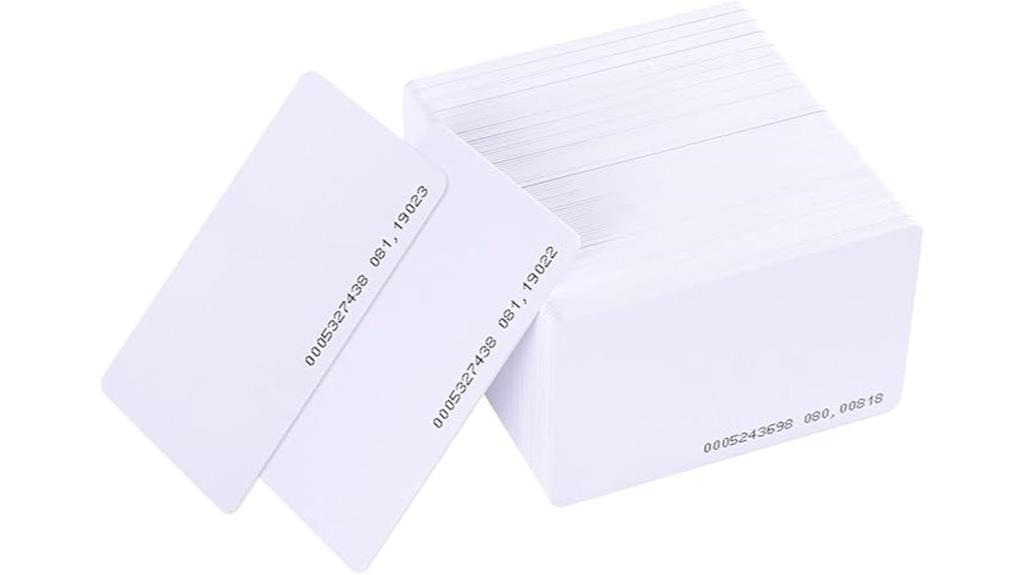
PCS RFID ID Cards for Entry Access Control are an excellent choice for organizations managing large user bases, thanks to their bulk packaging and cost-effective design. With 100 cards included, they offer a practical solution for businesses, apartment complexes, or institutions needing secure, contactless access. Compatible with standard 125kHz RFID systems, these slim cards are easy to carry and install. Their read-only functionality enhances security by preventing data cloning. Durable and reliable, they provide quick, seamless entry without keys or codes. Manufactured by NCLTHS, these cards are a smart, affordable way to streamline access control and improve security across various settings.
Best For: organizations, businesses, and property managers needing bulk, secure, contactless access control solutions for large groups of users.
Pros:
- Cost-effective bulk package ideal for large-scale deployment
- Compatible with standard 125kHz RFID systems, ensuring easy integration
- Read-only functionality enhances security by preventing data cloning
Cons:
- Batteries are not included or required, which may limit certain features if battery-powered functions are desired
- Limited to contactless access, which may not suit environments requiring physical key access
- Slim design may be more susceptible to damage if not handled carefully
AirTags 4-Pack Waterproof Bluetooth Item Trackers for Apple Find My
For iOS users seeking a reliable and waterproof item tracker, AirTags 4-Pack Bluetooth Trackers stand out with their seamless integration into the Apple Find My ecosystem. These small, lightweight tags are IP68 rated, making them resistant to water, rain, and splashes—perfect for outdoor use. They attach easily to keys, luggage, wallets, or even pets, helping you locate items via the Find My app or Siri. Though they emit sound to aid in locating, the volume can be low in noisy settings. Setup is straightforward, but replacing batteries involves unscrewing tiny screws. Overall, they’re a practical, cost-effective choice for iOS users needing waterproof tracking solutions.
Best For: iOS users seeking an affordable, waterproof, and easy-to-use item tracker for keys, luggage, wallets, or pets.
Pros:
- Seamless integration with Apple Find My app and Siri for easy location tracking
- Waterproof (IP68 rated), suitable for outdoor activities and various environments
- Compact, lightweight design with included accessories for attaching to different items
Cons:
- Low sound volume, making it difficult to locate items by sound in noisy environments
- Battery replacement requires unscrewing tiny screws, which can be inconvenient
- Limited to iOS devices, with no support for Android systems
Looking for a reliable Bluetooth item locator that’s seamlessly compatible with Android devices? The Tracker Tag for Android, Smart Tags 4-Pack, is an excellent choice. These Google-certified tags quickly pair via the Google Find Hub app and work best with Android, not iOS. They’re small, lightweight, and easy to activate—just turn on Bluetooth, and the app handles the rest. With real-time proximity alerts, visual cues, and accessories like key rings and silicone sleeves, they’re versatile for keys, luggage, or pets. Batteries last 8-12 months, and swapping them takes seconds. While some setup issues may occur, overall, these tags offer a secure, privacy-focused solution for everyday item tracking.
Best For: Android users seeking a privacy-focused, easy-to-use Bluetooth item tracker for keys, luggage, wallets, or pets.
Pros:
- Seamless pairing and real-time proximity alerts via Google Find Hub app.
- Long-lasting batteries (8-12 months) with quick, tool-free replacement.
- Compact, lightweight design with versatile accessories like key rings and silicone sleeves.
Cons:
- Limited to pairing with a single device during its lifetime, requiring re-pairing if changing phones.
- Outdated documentation may cause setup confusion, especially with older app references.
- Potential durability issues when opening cases or replacing batteries, and some users report connectivity problems.
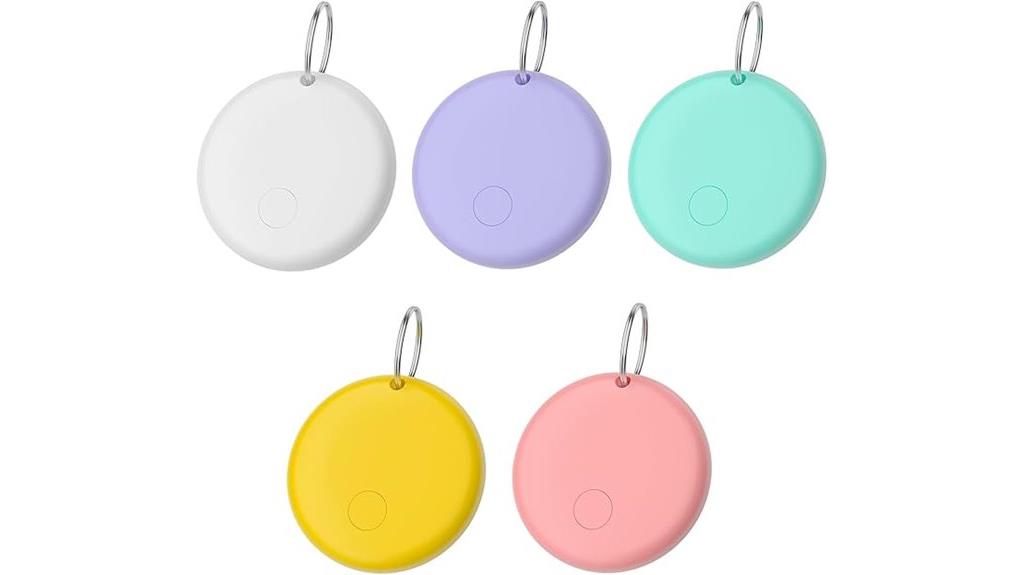
If you’re an iOS user seeking a reliable and durable tracker, the Pack Upgraded Air Tags Tracker Finders stand out with their IP68 waterproof rating and seamless integration with Apple’s Find My app. These sleek, compact trackers help locate keys, wallets, backpacks, luggage, and even pets. They’re easy to set up—just remove the nylon cover, press a button, and pair via the app. With advanced Bluetooth, they emit loud sounds to find lost items within 30-50 meters. Designed for outdoor use, they feature a durable plastic body with a built-in hole for attachments, offering a long-lasting battery life of about two years.
Best For: iOS users seeking an affordable, waterproof, and easy-to-use tracker for personal belongings and pets that seamlessly integrates with the Apple Find My app.
Pros:
- Easy setup with quick pairing via the Find My app
- Waterproof design with IP67 rating, suitable for outdoor activities
- Long-lasting replaceable battery lasting approximately 24 months
Cons:
- Lacks GPS and Precision Finding capabilities for more precise location tracking
- Sound volume may be insufficient in very noisy environments
- Slight discrepancy in waterproof rating (claimed IP68, tested IP67)
Factors to Consider When Choosing Wildlife Tracking RFID Tags
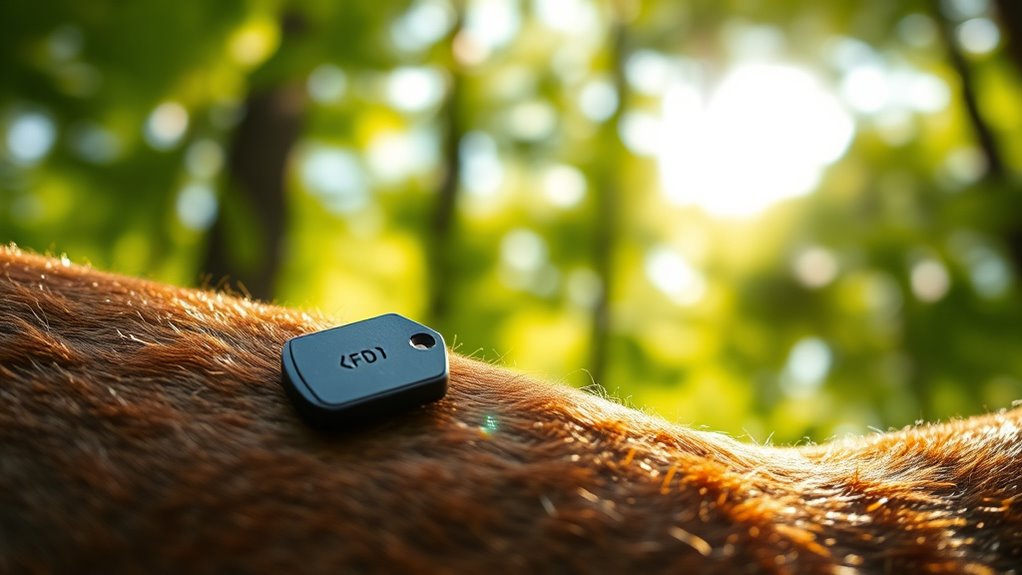
When selecting wildlife tracking RFID tags, I consider several key factors to guarantee the best fit. Compatibility with the species, size, environmental durability, data capacity, and implantation methods all play vital roles. Understanding these points helps me choose the right tag for effective and ethical tracking.
Compatibility With Species
Choosing the right wildlife tracking RFID tags requires careful attention to their compatibility with the species you’re studying. Different animals, such as fish, birds, or mammals, may need specific tag sizes and materials that suit their biology. It’s essential to verify that the RFID frequency matches your existing readers, ensuring smooth data collection. I also consider the environmental conditions; selecting tags made from biocompatible, waterproof materials guarantees durability and safety. Depending on the species, tags should be attachable via rings, adhesives, or injectable options, minimizing stress and impact. Ultimately, I check if the tags meet standards like ISO 11784/11785, so they integrate seamlessly with professional research systems. Compatibility is fundamental to effective, ethical wildlife tracking.
Tag Size and Shape
Selecting the appropriate size and shape of RFID tags is essential for making certain they fit comfortably and function effectively for the target species. Smaller, compact tags like 8mm x 1.25mm are ideal for small animals such as fish and birds, reducing discomfort and preventing interference with natural behaviors. Round or oval shapes are commonly used because they’re easier to inject and stay securely in place, minimizing the risk of shedding. The thickness of tags also matters; ultra-thin options around 0.15mm are less invasive and help maintain the animal’s mobility. Sometimes, custom or specialized shapes are necessary—flat tags for laminated identification or uniquely contoured designs for specific species or habitats. Proper size and shape choice to make certain effective tracking without compromising animal wellbeing.
Environmental Durability
The durability of RFID tags in outdoor environments depends heavily on their construction and protective features. I look for tags made from weather-resistant materials like bioglass or biocompatible plastics, ensuring they withstand harsh conditions. Waterproofing is essential; I prefer tags rated at IP67 or IP68 to ensure reliable performance in wet or submerged habitats. Temperature tolerance is critical—top-quality tags operate smoothly between -25°C and 70°C, preventing failures in extreme climates. Resistance to corrosion from moisture, saltwater, and other elements guarantees long-term functionality. Additionally, the tags must resist UV exposure, pressure, and physical impacts to endure field deployment. These factors collectively ensure that the RFID tags remain dependable, providing consistent data collection and supporting effective conservation efforts over time.
Data Storage Capacity
Have you ever wondered how much information a wildlife RFID tag can hold? The data storage capacity of these tags varies widely, from just a few bytes to several hundred, depending on the model. Basic tags, often small and injectable, typically offer around 137 bytes, suitable for storing a unique ID, species, and deployment date. Larger tags provide more space, allowing for detailed metadata and updates through rewritable memory. This capacity directly impacts what information can be stored without relying on external databases. When choosing a tag, you need to balance storage needs with size constraints, especially for animals where minimal size is essential. Higher capacity tags enable richer data collection, but may come with trade-offs in size or cost.
Implantation Method
When considering how to deploy RFID tags on wildlife, the method of implantation plays a key role in ensuring the device stays secure and functions effectively. Injectable transponders are commonly used, designed to minimize animal discomfort and reduce the risk of dislodgement. Transdermal implantation involves inserting RFID tags beneath the skin with sterile needles or implanter devices, providing a secure placement within tissue. The size and shape of the tag influence the implantation method; micro-sized tags often require fine needles for minimal invasiveness. Proper technique is essential to prevent tissue damage, infection, or tag shedding, especially in aquatic or challenging environments. Injectable RFID tags are built to be durable and biocompatible, supporting long-term tracking without external attachments or frequent re-implantation.
Power and Battery Life
Choosing the right RFID tag for wildlife tracking hinges considerably on its power source and battery life, which directly affect the success of long-term monitoring. Most RFID tags use lithium coin cells, like CR2032, with lifespans ranging from six months to three years, depending on technology and usage. Low-frequency (125kHz) tags tend to consume less energy than high-frequency or UHF variants, making them more suitable for extended deployments. Reusable tags often feature long-lasting batteries and low-power modes to maximize operational life in the field. Environmental factors such as extreme temperatures, moisture, and physical wear can shorten battery life, requiring replacements or recharging. Some advanced tags incorporate energy harvesting or low-power electronics, helping extend battery life and reducing maintenance for long-term projects.
Data Security Features
While security features are often overlooked in wildlife RFID tags, they play a crucial role in ensuring the integrity and authenticity of the data collected. Most RFID tags used in wildlife tracking are designed to focus on data accuracy rather than advanced encryption, with minimal security measures. Many tags are read-only or semi-rewritable, which helps prevent unauthorized data tampering. Unique identifiers on secure tags prevent cloning and impersonation, maintaining data authenticity. However, the security of data transmission depends on the protocols used; many operate under basic ISO standards with limited security. Given environmental challenges and durability needs, manufacturers often prioritize physical robustness over sophisticated security features, making them reliable but less protected against cyber threats.
Cost and Budget Limits
Cost considerations often shape the selection of wildlife RFID tags just as much as their security features. Prices vary widely, from just a few cents for basic models to several dollars for high-performance, durable options. Budget constraints can limit choices, affecting size, material, and data capacity—more affordable tags usually offer fewer features. Larger projects might buy in bulk to reduce costs per tag but require higher upfront investment. It’s essential to weigh initial costs against long-term benefits like durability, reusability, and system compatibility. Don’t forget to include expenses for implantation tools, readers, and data management software in your overall budget. Balancing these factors helps ensure the project remains financially viable while meeting research needs effectively.
Frequently Asked Questions
How Do RFID Tags Impact Wildlife Behavior and Health?
When I think about RFID tags’ impact on wildlife behavior and health, I realize they’re minimally invasive, causing little stress or disruption. These tiny devices help me monitor animals’ movements, habits, and health without interference. While there’s a small risk of irritation or infection, proper application and care greatly reduce these concerns. Overall, I believe RFID tags are invaluable for understanding and protecting wildlife while keeping their well-being a priority.
What Is the Average Lifespan of a Wildlife RFID Tracking Tag?
You’re wondering about the average lifespan of a wildlife RFID tracking tag. From what I’ve researched, most tags last between 1 to 3 years, depending on their type and usage conditions. Passive RFID tags tend to last longer since they don’t have batteries, while active ones with batteries usually last around a year or two. Factors like environmental exposure and the animal’s activity level also influence their longevity.
Are RFID Tags Safe for Long-Term Environmental Exposure?
Imagine tiny guardians quietly watching over wildlife’s journey. I believe RFID tags are generally safe for long-term environmental exposure when made with biocompatible materials. They’re designed to withstand the elements—rain, sun, and dirt—without harming animals or ecosystems. Manufacturers rigorously test these tags to guarantee durability and safety. So, rest assured, these small devices act like faithful sentinels, blending into nature’s tapestry without disturbing its delicate balance.
How Do RFID Tags Compare to GPS Trackers in Conservation Efforts?
When comparing RFID tags to GPS trackers in conservation, I find RFID tags are more discreet, cost-effective, and suitable for tracking many animals simultaneously. They don’t require batteries and are less invasive, but they only work at close range. GPS trackers provide precise location data over larger areas, which is great for studying movement patterns. I think choosing depends on your specific conservation goals and the species you’re monitoring.
What Are the Ethical Considerations in Wildlife RFID Tagging?
Thinking about RFID tagging in wildlife is like walking a tightrope — it’s vital to balance benefits with ethical responsibilities. I believe it’s essential to guarantee minimal discomfort, avoid disrupting natural behaviors, and protect animals’ privacy. Constantly questioning whether the data collection harms or benefits the species keeps me vigilant. Responsible tagging requires transparency, proper consent (where applicable), and ongoing assessment to ensure conservation goals don’t overshadow animal welfare.
Conclusion
In my experience, choosing the right wildlife RFID tag can truly transform conservation efforts. Did you know that RFID tracking has helped increase bird migration tracking accuracy by 30%? It’s exciting to see how these tiny tags make a huge difference in understanding and protecting wildlife. Whether you’re tracking birds, fish, or mammals, the right RFID technology can help us make smarter, more impactful conservation decisions. Together, we’re making a real difference for our planet’s future.








